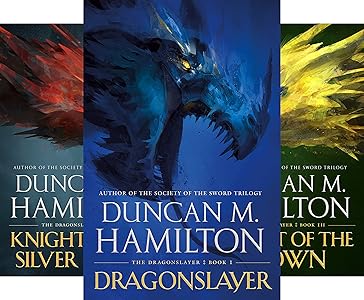
![]() Knight of the Silver Circle by Duncan M. Hamilton
Knight of the Silver Circle by Duncan M. Hamilton
I gave a “didn’t recommend” to Duncan M. Hamilton’s Dragonslayer, noting that while it had some good pacing and a smooth, easy flow to it, that the story and characters were both a bit overly familiar and flat. Despite my rating though, when the sequel, Knight of the Silver Circle (2019) appeared, I picked it up, figuring it would be a pretty quick read and somewhat curious as to whether there had been any improvement. The good news is the answer was yes, while the less good news is many of the same issues from book one are still in place. Note there’ll be some unavoidable spoilers for book one to follow.
Knight of the Silver Circle picks up shortly after its predecessor, with Gill and Solene having worked together to kill the dragon that drove much of the first book’s action. Their success was thanks to Solene having figured out how to use the Cup, an ancient artifact, to bestow magical protection on Gill as had been done in legendary times by the Chevaliers of the Silver Circle, a once highly respected elite group of magic-wielding knights who had long since devolved into basically an old man’s drinking club, and then not even that, since Gill was the last of even that motley group. Now, though, Solene has to return to the Academy to further her training, since her lack of control over her magical abilities threatens both her own life and those around her. Meanwhile, Gill has just learned of three more dragons, younger ones, that have appeared (the dragon in book one was the first in centuries).
Each therefore sets out on their own quest. Solene back to the city and her lessons, where she’ll become embroiled in the court intriguing of the series’ villain, Amaury the Prince Bishop, founder of the new Order of mages and an ambitious man who has already killed one king and is contemplating doing it again as he seeks ever more power, both secular and magical. Out in the country, Gill puts out a call for warriors seeking fame, trying to get some help before taking on the new dragons. The story is further complicated by the addition of a new character, Pharadon, a newly-awakened older, “enlightened” dragon — one who is highly intelligent, rational, and against violence. Sensing the three younger dragons, Pharadon is in a race to help them achieve enlightenment before they and humans come into conflict.
As with the first book, Hamilton shows a deft hand at pacing and structure. Knight of the Silver Circle moves along at a good clip, and it all goes down quite smoothly as we shift amongst the various points of view. There’s a natural ease to the writing that just carries the reader along. Gill is a likable character, the typical worn-down underdog trying to do the right thing despite his own flaws, weaknesses, and personal desires. Amaury, meanwhile, is a decently mixed kind of villain, a sort of Cardinal Richelieu-type a la Dumas, with his seemingly sincere justification that all he does is for the good of the state. If that means killing a few people (or more) here and there, including a king or two and their advisors, so be it.
As likable as Gill is and as grey as Amaury is, though, the characters remain overly familiar; we’ve seen these types many times before and in much more rich versions (particularly with regard to Amaury, whose grey is more of a tint). And the side characters are pretty two-dimensional, given too little page time to fully flesh them out. The same is true of Solene, who isn’t a side character but feels like one through much of the novel. And if the pacing is quick and the book goes down smoothly, part of the reason for that beyond Hamilton’s gifts as a storyteller is that much of the plot happens too easily. Even when things go badly, as when people die, it frequently happens semi off-stage so to speak and, in any case, always happens via a speedy conflict — resolution — move on sort of structure. There’s little true sense of struggle, of complications, even when the characters tell us they are struggling or things are too complicated. In many ways, in its brevity, thin world-building and simple characterizations, it felt a bit like younger YA (and no, I’m not claiming all YA has simple characterization, etc.). I don’t think it’s aimed at that group, but I think they’d most likely enjoy it. I can also see adult readers who like a simple, quick, easy to quaff story with some human-dragon conflict, a bit of complicating plot, and a likable main character and don’t necessarily require or desire lots of details regarding characters and setting enjoying the series as well.
For me, while I did find Knight of the Silver Circle an improvement over its predecessor, I still need more than Hamilton is offering here. That said, I’m going to note that my not-recommended for that first book is somewhat lessened by this sequel for just those sort of readers described above.



COMMENT Was I hinting that? I wasn't aware of it. But now that you mention it.... 🤔
So it sounds like you're hinting Fox may have had three or so different incomplete stories that he stitched together,…
It's hardly a private conversation, Becky. You're welcome to add your 2 cents anytime!
If the state of the arts puzzles you, and you wonder why so many novels are "retellings" and formulaic rework,…
I picked my copy up last week and I can't wait to finish my current book and get started! I…